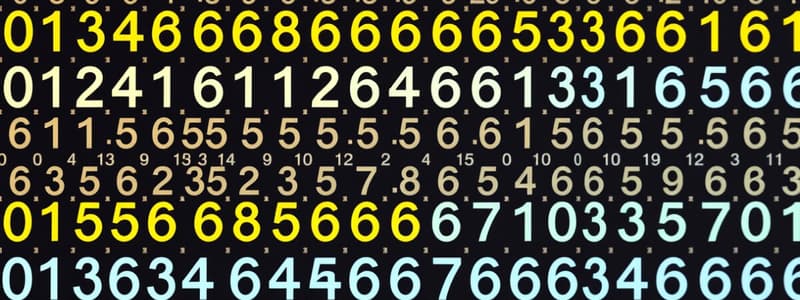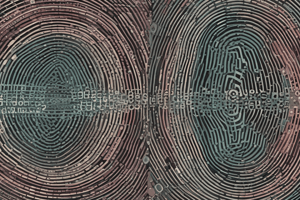Podcast
Questions and Answers
Which description accurately defines a geometric sequence?
Which description accurately defines a geometric sequence?
- A sequence where each term is the product of the previous term and a constant. (correct)
- A sequence of numbers that are all prime.
- A sequence that involves alternation between two constants.
- A sequence that increases by adding a constant.
What is the magic constant for a 3x3 magic square?
What is the magic constant for a 3x3 magic square?
- 18
- 9
- 12
- 15 (correct)
In an arithmetic sequence where the first term is 5 and the common difference is 3, what would be the 6th term?
In an arithmetic sequence where the first term is 5 and the common difference is 3, what would be the 6th term?
- 18
- 26
- 20
- 23 (correct)
Which of the following represents a Fibonacci pattern?
Which of the following represents a Fibonacci pattern?
Which characteristic is true of infinite sequences?
Which characteristic is true of infinite sequences?
How is the Siamese method used in constructing magic squares?
How is the Siamese method used in constructing magic squares?
What type of pattern is indicated by the arrangement circle, triangle, circle?
What type of pattern is indicated by the arrangement circle, triangle, circle?
Which of the following sequences is NOT a characteristic of a magic square?
Which of the following sequences is NOT a characteristic of a magic square?
Study Notes
Number Patterns
- Definition: A sequence of numbers that follows a particular rule or formula.
- Types of Patterns:
- Arithmetic: Involves adding or subtracting a constant (e.g., 2, 4, 6, 8).
- Geometric: Involves multiplying or dividing by a constant (e.g., 3, 6, 12, 24).
- Fibonacci: Each number is the sum of the two preceding ones (e.g., 0, 1, 1, 2, 3, 5).
- Identifying Patterns:
- Look for consistent changes between numbers.
- Recognize if the pattern is linear, quadratic, exponential, etc.
Sequencing
- Definition: The arrangement of numbers or objects in a specific order.
- Types of Sequences:
- Finite Sequence: A sequence that has a limited number of terms (e.g., 1, 2, 3).
- Infinite Sequence: A sequence that continues indefinitely (e.g., 1, 2, 3, ...).
- Common Sequences:
- Arithmetic Sequence: Difference between consecutive terms is constant.
- Geometric Sequence: Ratio between consecutive terms is constant.
- Finding Terms:
- Use formulas based on the type of sequence (e.g., nth term formula for arithmetic).
Magic Squares
- Definition: A grid (usually 3x3 or larger) filled with numbers so that every row, column, and diagonal sums to the same number.
- Properties:
- Magic Constant: The sum of numbers in rows, columns, or diagonals (for a 3x3 grid, it’s 15).
- Order of Square: Refers to the number of rows/columns (e.g., 3x3 is order 3).
- Construction Techniques:
- Siamese Method: Start in the middle of the top row and place numbers diagonally.
- Doubly Even Order: Divide the square into quadrants and fill in a specific pattern.
Picture Patterns
- Definition: Visual arrangements of shapes or images that follow a specific rule or sequence.
- Types:
- Repetitive Patterns: A sequence where shapes or colors repeat (e.g., circle, triangle, circle).
- Growing Patterns: Shapes that increase in number or size (e.g., 1 star, 2 stars, 3 stars).
- Identifying Patterns:
- Analyze the order and frequency of shapes.
- Look for transformations (e.g., rotations, reflections, translations).
- Applications:
- Used in art, design, and architecture to create aesthetic appeal.
Number Patterns
- Definition: A number sequence adhering to a specific calculation rule.
- Types of Patterns:
- Arithmetic Patterns: Progression where a constant is added or subtracted, e.g., 2, 4, 6, 8.
- Geometric Patterns: Each term is generated by multiplying or dividing by a constant, e.g., 3, 6, 12, 24.
- Fibonacci Sequence: Each number results from the sum of the two preceding numbers, starting with 0 and 1, e.g., 0, 1, 1, 2, 3, 5.
- Identifying Patterns: Examine consistent number changes and determine if the pattern is linear, quadratic, or exponential.
Sequencing
- Definition: Organization of numbers or objects in a defined order.
- Types of Sequences:
- Finite Sequence: Contains a specific, limited number of terms, e.g., 1, 2, 3.
- Infinite Sequence: Extends indefinitely without an end, e.g., 1, 2, 3,...
- Common Sequences:
- Arithmetic Sequence: Features a constant difference between terms.
- Geometric Sequence: Exhibits a constant ratio between consecutive terms.
- Finding Terms: Utilize specific formulas for sequence types, particularly the nth term for arithmetic sequences.
Magic Squares
- Definition: A grid system (typically 3x3) populated by numbers where all rows, columns, and diagonals yield the same sum.
- Properties:
- Magic Constant: The uniform sum of the rows, columns, or diagonals; in a 3x3 grid, it sums to 15.
- Order of Square: Indicates the number of horizontal and vertical alignments, e.g., a 3x3 structure indicates order 3.
- Construction Techniques:
- Siamese Method: Initiate placement in the central top row, arranging numbers diagonally.
- Doubly Even Order: The grid is partitioned into quadrants, filled using a defined pattern.
Picture Patterns
- Definition: Visual sequences of shapes or images that follow specific rules.
- Types:
- Repetitive Patterns: Sequences where shapes or colors repeat in a defined order, such as circle, triangle, circle.
- Growing Patterns: Displays where shapes increase in quantity or size, for example, from 1 star to 3 stars.
- Identifying Patterns: Assess the sequence and frequency of shapes while observing for transformations like rotations or reflections.
- Applications: Utilized in creative fields like art, design, and architecture to enhance visual appeal.
Studying That Suits You
Use AI to generate personalized quizzes and flashcards to suit your learning preferences.
Description
Test your knowledge on number patterns and sequences with this insightful quiz. Explore different types of patterns such as arithmetic, geometric, and Fibonacci, as well as various sequences like finite and infinite. Challenge yourself to identify and understand these mathematical concepts.




